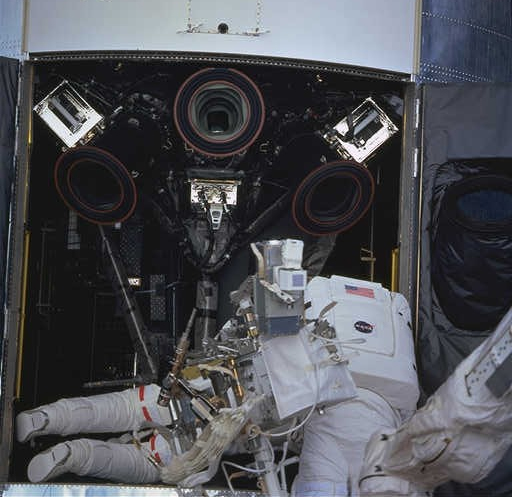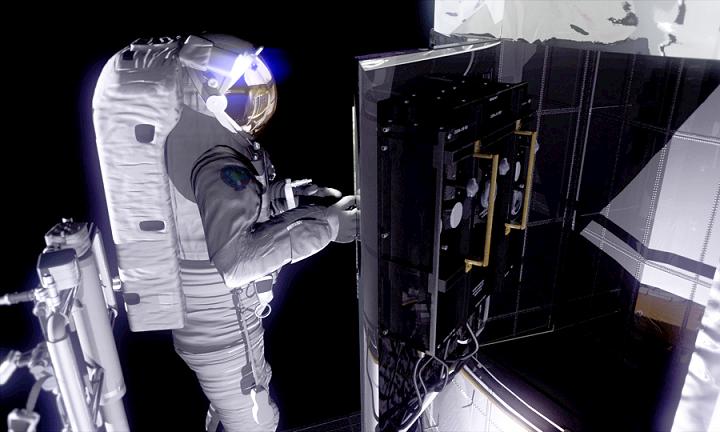In preparation for the launch of the Atlantis STS-125 mission to repair the Hubble Space Telescope, which is expected on May 12, we bring the details of the mission as published by NASA. And this time - which devices will the astronauts fix

On the first spacewalk, which will take place on the fourth day of the journey, Grunsfeld and Feustel will replace the wide-field camera, and then they will replace the scientific data processing computer that caused the delay of the flight since October. In addition, they will install a mechanism that will allow the spacecraft to capture Hubble and cause it to crash on Earth after the end of its activity.
Throw away the old
Many of the components of the Hubble Space Telescope, especially the instruments, were designed to be easily removed and replaced during servicing missions. The scientific priority in this mission is to install new instruments on Hubble - the Wide Field Camera 3 (WFC3), and the Cosmic Origins Spectrograph (COS).
The Planetary Field Camera 3 will be the driving force for studies in the field of dark energy and dark matter, the birth of individual stars and the discovery of extremely distant galaxies that were previously out of Hubble's field of view. WFC3 will observe the universe in three different frequencies of light: near ultraviolet, visible light, and near infrared, but not simultaneously. The shooting range of the telescope is greater than that of the instruments on board the telescope. The astronauts will remove the previous camera, Planetary Camera No. 2 to make room for No. 3. WFC3 has a higher resolution and a larger field of view than its predecessor.
The evolution of galaxies, the creation of planets, the increase in the proportion of heavy elements essential to life and the "cosmic network" of gas between galaxies will be some of the areas that will be investigated using the origin of the universe spectrograph. A spectrograph is a device that breaks down light into its color components, and will reveal data about the light emission of the photographed object. COS will observe exclusively in the ultraviolet range and will improve the Hubble's sensitivity in this frequency range at least 10 times and up to 70 times when the Hubble will observe extremely pale objects.
COS will replace an instrument installed on Hubble during the first servicing mission to help correct the effect of the damaged mirror - the Corrective Optics Space Telescope Axial Replacement (COSTAR). . Since the first mission, all instruments installed on Hubble have contained technology that corrects the effect of defective lenses, thus making COSTAR an unnecessary instrument.
Two of the instruments on Hubble - the Advanced Camera for Surveys (ACS) and the Space Telescope Imaging Spectrograph (STIS) - require repairs. ACS, which partially stopped working in 2007 due to a short circuit, is a workhorse camera responsible for most of Hubble's spectacular images. The STIS is a spectrograph that observes ultraviolet, visible, and near-infrared light and is known for its ability to hunt black holes. While COS works great against small light sources such as stars or quasars, the STIS maps large objects such as galaxies. STIS suffered power outages in 2004 and was put into hibernation to preserve for the possibility of its repair.
The astronauts plan to repair both instruments – a challenging approach because these repairs were outside the scope of Hubble's servicing missions. The telescope designers envisioned astronauts replacing components and not performing delicate surgery during a spacewalk. An internal electronics box inside the ACS supplies the electricity to the detectors, and contains equipment affected by the electrical flash. However, the location of the box makes it inaccessible to astronauts. So instead of trying to reach the problematic part, the astronauts will try to bypass the shortened components. The power supply is connected by cables to a series of electronic boards that are in an accessible place but have no power due to the damaged box. The astronauts will install a new power supply device and attach it to one of the grip handles near the outside of the ACS, direct the electronic boards and install new ones compatible with the new power supply system, and connect them to the power outage via external cables. The arrangement will simply take the damaged box out of the equation.
The STIS device requires a new electrical circuit for the power supply. The repair would be relatively easy except for the electronic access panel, which was not designed to open and is attached to the STIS with 111 small screws. In space conditions, it is very difficult to turn the screws using the astronaut's glove. In particular, the fear is that the screws will come loose and fly around and cause additional damage, when they hit electronic components. Therefore, the engineers created a quick capture plate that is worn on top of the panel. When the astronauts remove the screws they will be trapped in the plate. The astronauts will replace the board and connect it easily using two pedals.
After all devices and components are assembled or repaired, the Goddard control center personnel will perform tests to ensure that everything is working properly. Once the work is complete, Hubble will be ready for a peak performance of five instruments, WFC3, COS, ACS, STIS, and the Near-Infrared Camera and Multi-Object Spectrograph (NIMCOS).
However, before testing the new instruments, the telescope will also be required for maintenance. And in particular the replacement of the batteries that store the energy that powers the telescope during the night segments in orbit, when the Earth blocks the sun's rays. The astronauts will replace all six batteries that weigh about 57 kg each with new and more efficient batteries. The telescope's six gyroscopes are part of the system that directs it to the desired photo target. When all six gyroscopes are functioning, three are used for pointing and the others are kept in reserve. Over time the gyroscopes wore out and three of them have already stopped working, two are still working and the third is turned off to be used as a backup in case of emergency. The astronauts will install six new gyroscopes.

Hubble's Fine Alignment Sensors (FGS) lock onto guide stars that help align the telescope. They can also be used as instruments for measuring the position of stars in relation to other stars. The astronauts will replace one damaged FGS with a refurbished device issued during a previous servicing mission.
The Hubble's insulating cover, which keeps the devices at normal operating temperature, eventually disintegrated due to exposure to space conditions. The astronauts will cover the Hubble's equipment bays with fresh insulation known as the New Outer Blanket Layer (NOBL). Finally, they will install another component - a soft capture mechanism. The simple device will allow a robotic spacecraft to dock itself to Hubble one day, when the telescope's end of life is decided.
When the astronauts have completed all their tasks they will use the robotic arm again to release the telescope and Goddard will transmit commands to it to bring it back into operation. However, before resuming Hubble's scientific mission, the telescope will undergo a series of experiments lasting several months in order to recalibrate it. The new images from the telescope will be published towards the end of 2009.
Restored and updated, the Hubble will continue its journey around the Earth. Its new components will integrate transparently with the old ones, and the upgraded telescope (upgraded and new) will be ready for years of breakthrough discoveries in the universe. The knowledge site will continue and update in preparation for and during the mission.

4 תגובות
You wrote that new pictures will be received from Hubble at the beginning of 2009,
I assume that the intention was for the year 2010, because the beginning of 2009 will no longer be...
Thank you! Very interesting
I am amazed by the discovery of the source of the lens malfunction.
That alone is worth a Nobel Prize!